Dell U3011 Review: Dell's New 30-inch Flagship
by Brian Klug on January 13, 2011 9:17 PM ESTViewing Angles
The U3011 has superb viewing angles, just like we've grown accustomed to seeing from IPS panels. Even at the far extreme horizontally, there's none of the purple I'm used to seeing from TN panels as you move off-axis. In the vertical direction, I saw the same thing with almost nothing to complain about. I did notice some glare at the extreme angles, but again that's dependent on where you're sitting and where light sources are located.
I think this is an excellent opportunity to talk about IPS graininess, something we really haven't discussed before. Of the IPS panels I've used to date, all of them have had some high frequency grain on the surface from a combination of coating and interference at the interface. Thankfully the U3011 has a combination antireflection coating and hard coating, and subjectively there seems to be less grain than I've seen on other displays.
Color Quality
Next up are the ever-important color quality metrics. As usual, we report two main quality metrics: color accuracy (Delta-E) and color gamut. Color gamut refers to the range of colors the display is able to represent with respect to some color space. In this case, our reference is the AdobeRGB 1998 color space, which is larger than the sRGB color space. Our percentages are thus reported with respect to AdobeRGB 1998, and larger is generally better unless you're dealing with sRGB content and colorspace-unaware software.
Color accuracy (Delta E) refers to the display’s ability to display the correct color requested by the GPU and OS. The difference between the color represented by the display, and the color requested by the GPU is our Delta-E, and lower is better here. In practice, a Delta E under 1.0 is perfect - the chromatic sensitivity of the human eye is not great enough to distinguish a difference. Moving up, a Delta E of 2.0 or less is generally considered fit for use in a professional imaging environment - it isn’t perfect, but it’s hard to gauge the difference. Finally, Delta E of 4.0 and above is considered visible with the human eye. Of course, the big consideration here is frame of reference; unless you have another monitor or some print samples like a Gretag Macbeth color checker card to compare your display with, you might not notice.
As I mentioned in our earlier reviews, we’ve updated our display test bench. We’ve deprecated the Monaco Optix XR Pro colorimeter in favor of an Xrite i1D2 since there are no longer up-to-date drivers for modern platforms. We're trying to find an i1Pro to use as well.
For these tests, we calibrate the display and try to obtain the best Delta-E we can get at both 200 nits of brightness for normal use, and 100 nits for print brightness. We target D65 and a gamma of 2.2, but sometimes the best performance lies at native temperature and another gamma, so we try to find what absolute absolute best-case performance for each display. We also take an uncalibrated measurement to show performance out of the box using either the manufacturer supplied color profile, or a generic one with no LUT data. For all of these, dynamic contrast is disabled, and displays are left to settle for a half hour after making changes. The U3011 is CCFL-backlit, and I used a settle time of 30 minutes accordingly.
First up is uncalibrated Delta-E performance. For this test, I took the monitor out of the box, connected it over DisplayPort, adjusted to 200 nits, and ran our usual GMB color checker test. Results aren't that great, sadly.
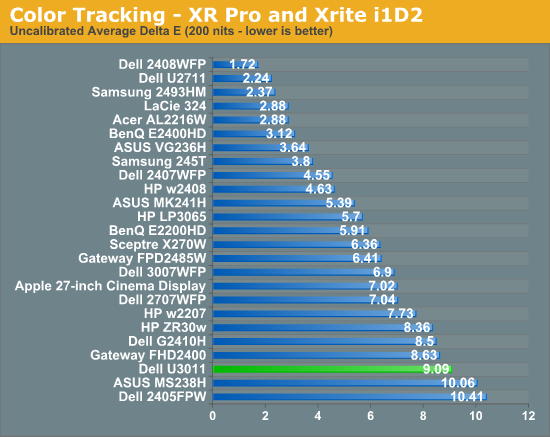
I mentioned earlier that the U3011 we got from Dell for testing came with no factory calibration report. After checking up with them, we learned this is a pre-production unit identical to what's shipping now, minus that factory calibration. That's something we can live with, especially since we recommend every display be calibrated, but still unnerving.
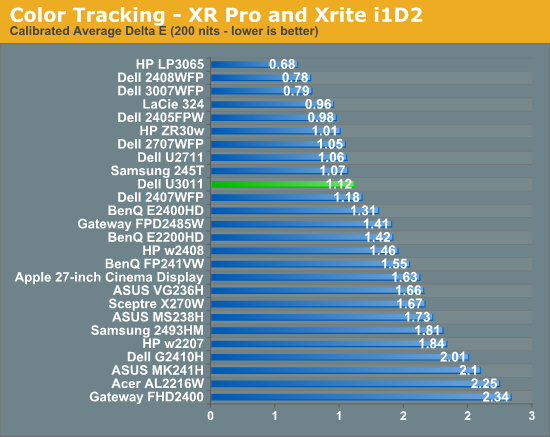
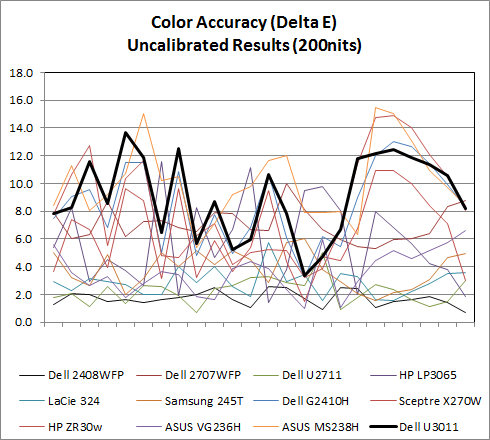
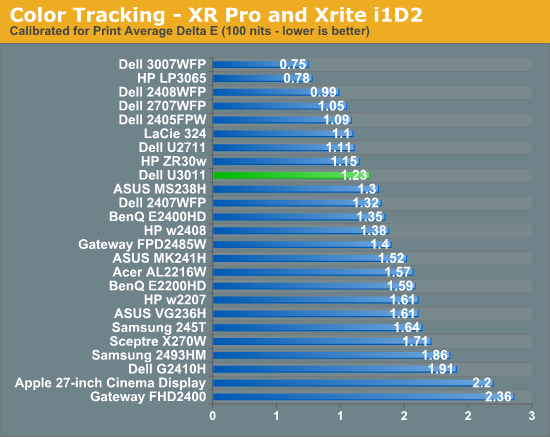
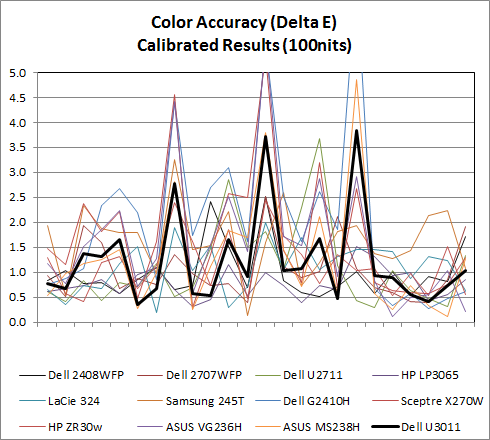
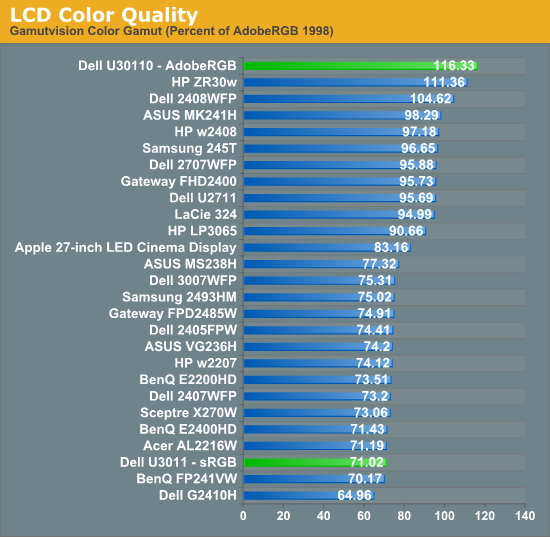

AdobeRGB Mode
sRGB Mode
Calibrated Delta-E is very good, though I'm still surprised the U3011 can't get under 1.0 on our tests. I'm starting to suspect that our i1D2 isn't quite as good as the Monaco Optix XR Pro, and have started looking for an i1Pro spectroradiometer as a result so we can have something more accurate going forward. That said, performance is still more than adequate for professional work. These two calibrations were performed in the sRGB mode at D65.
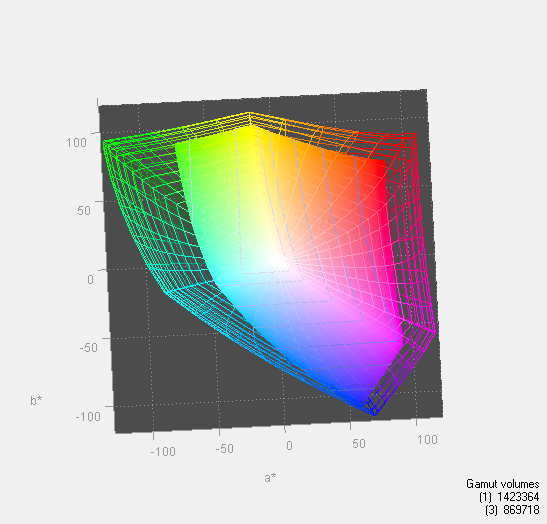
In addition, the U3011 has modes for AdobeRGB color space and sRGB in the OSD, something extremely useful for doing work and not getting oversaturation in applications that lack color management. You can immediately see the effect of those two modes in the color gamut measure above. Letting the monitor free to use its entire gamut of color, it leads the pack. Turn sRGB mode on, and it clamps down just nicely. 116.33% is also shockingly close to Dell's advertised 117% coverage of CIE 1796 (AdobeRGB), which is awesome to see confirmed above.








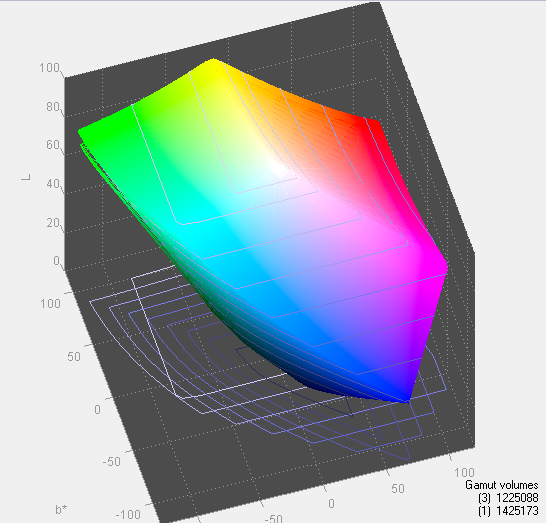
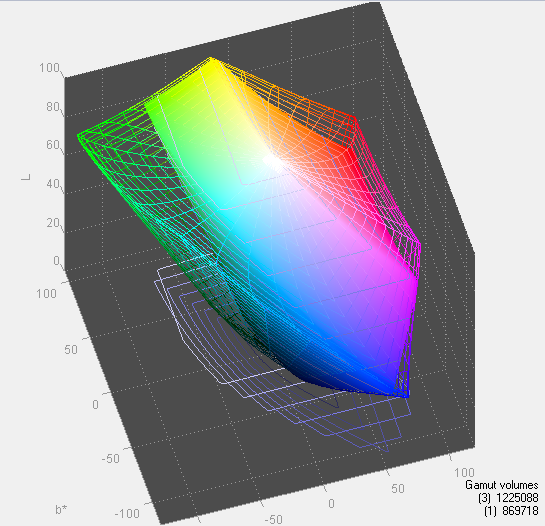








123 Comments
View All Comments
Drag0nFire - Friday, January 14, 2011 - link
Wondering if anyone can help me compare the coating on the U3011 vs the U2711. When I saw the U2711 (and the U2410) in person, I found in both cases that the screen had an obtrusive sort of matte anti-glare coating.I'm normally a fan of matte displays, but there seemed to be something wrong at the interface. The effect was similar to my 2G iPod Touch with a matte screen protector (on top of a glossy screen). It created a cloudy appearance, and one can see a sort of rainbow effect around white pixels.
I'm interested in purchasing a new high quality display, but this coating seems like it would impair day-to-day usage. Can anyone comment?
Thanks!
niva - Friday, January 14, 2011 - link
This review actually talked about the coating on the u3011 being noticeably better in comparison to previous implementations. I think it depends on the environment you'll run this in, my computer room is dark and the blinds rarely come up so something like that wouldn't even be an issue to me.optics261 - Monday, January 17, 2011 - link
the coating is VERY strong on this monitor... the coating makes the appearance of sparkles on any light/white areas of the screen. the fact that you are in a dark room means that you need coating even less.zanon - Thursday, January 13, 2011 - link
I believe that with a price beyond $1k screens are in a range that can reasonably be compared to high end displays like those manufactured by NEC and Eizo. I'd be very interested to see how color deltas and such stack up against models like the NEC 2690/3090 (calibrated via SpectraView) as well in order to better place it in the range of available options. Thanks for your great reviews.GTaudiophile - Thursday, January 13, 2011 - link
Problem with that is that the Eizo and NEC monitors in the same price class are 6 inches smaller. I think the 30" models from them break the $2K mark.Brian Klug - Thursday, January 13, 2011 - link
I completely agree actually, I'd really like to start reviewing some NEC and Eizo displays. We're working on getting those (I believe we'll see an NEC soon), but it's going to take a little bit.Completely agreed though!
-Brian
randomlinh - Thursday, January 13, 2011 - link
How about software properly scaling first? win7 works to an extent, but still looks wonkyzanon - Friday, January 14, 2011 - link
Fantastic to hear, and I totally understand if it'll take a bit to expand your testing range. You've already got a solid calibrator at least (the i1D2, same as I've got with my LCD2690) so you don't necessarily need the -SV package, just the normal screen since SpectraView II can be gotten separately. But I'll definitely look forward to seeing how the continued evolution of screens changes the picture (har har) in the market. At some point my workhorse NEC will surely give out.@GTaudiophile
You mean 4 inches smaller (26"), 30" screens tend to be around $1800 as you say, but more to the point I don't think that's actually too big a deal. If you're in the market for something this nice at all, pretty much by definitely you're already way outside the standard, and very likely to be willing to spend an extra few hundred bucks here or there if the performance is justified. By the same token, continued advancement may actually allow Dell etc to compete straight up with higher end screens for all but the rarest applications, and thus let us save some extra money as well. Either way, it'd be useful, so I'm excited that it's in the cards eventually.
GTaudiophile - Friday, January 14, 2011 - link
I dunno...looking at various prices for NEC and Eizo monitor, I have to conclude that DELL/HP are still fulfilling some sort of "value" niche when it comes to IPS monitors:NEC LCD2690WUXI2-BK-R: $759.00 (26")
NEC PA271W-BK: $1,399.00 (27")
NEC LCD3090WQXI-BK-R: $1,399.00 (Cheapest 30" model)
All prices, NEC.com.
Eizo ColorEdge CG303W (30" IPS): $5,035.00 @ BHphoto.com
Eizo ColorEdge CG243W (24.1" IPS): $2,346.00 @ BHphoto.com
For the price of the U3011, you can consider NEC's high-end 27" or low-end 30". I would like to see how the latter compares to the DELL, and I would like to see how that 27" compares to the U2711. The rest of the NEC 30" monitors break the $2K mark.
Eizo pretty much remains unapproachable for me.
My personal budget for a 27-30" IPS is between $1,000-$1500. Again, I want something for 1) General Office Use, 2) Digital Photography editing, and 3) Gaming.
GTaudiophile - Friday, January 14, 2011 - link
For what it's worth, I am still using my trusty DELL FP2001 from a decade ago!!! I have been debating on what to upgrade to for the past two years! Reading monitor reviews is nerve-wracking. Nothing is perfect out there...for the price you want! It's like either a $300 TN or a $3000 Eizo with not enough in between.